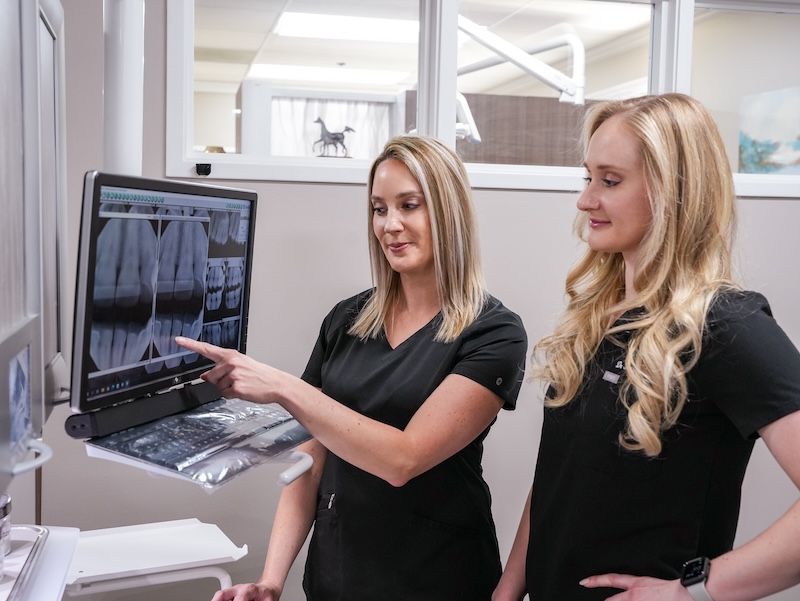If you have an infected, damaged tooth or overcrowded teeth, tooth removal may be your best treatment option. Advanced tooth extraction techniques are quick and painless so we can improve your oral health comfortably and conveniently. Take the first step toward enhancing your smile with tooth extraction at Bailey Dental Group in Richmond, MI.
Top reasons for tooth extractions:
- Cavities: When left untreated, cavities can significantly damage a tooth, to a point that it can no longer support a dental restoration.
- Gum Disease: Without timely treatment, the periodontal tissues and jawbone can pull away from the teeth and recede, resulting in loose teeth.
- Trauma: A car accident, sporting injury, or other traumatic event can result in broken, fractured, and damaged teeth that might not be savable.
- Orthodontic Treatment: In cases of overcrowding, we can remove permanent teeth so there is room for the remaining teeth to move into proper alignment.
- Wisdom Teeth: If the wisdom teeth are impacted or growing in at an angle, it can increase the risk of tooth movement, overcrowding, and infection.

Contact our practice to get started
Our dentists, Cynthia Bailey, DDS, and Tess Marie Finley, DDS, are a mother-daughter team committed to providing high quality dental care to patients from Richmond and surrounding areas. We are experienced in the use of advanced technology, including Spectra™ cavity detection and laser cavity systems to help us more precisely diagnose and treat oral health problems. We are also proud to be affiliated with several professional dental organizations, including the Michigan Dental Association and Academy of General Dentistry.
To schedule an appointment with our dentists, contact our dental practice online or call us in Richmond, MI, at (586) 800-2250.
How can I pay for tooth extraction costs?
Financing
We accept CareCredit financing, which can break the cost of care into affordable payments.
Insurance
Our team will determine how we can best utilize your insurance to reduce the cost of treatment.
Payment Options
For any of your out-of-pocket costs, we accept all major credit cards for your convenience.
What to expect during your treatment
A single tooth extraction procedure can be completed in just 30 minutes.
1. Administer Anesthesia
For simple extractions, a local anesthetic, or numbing solution, is often sufficient to keep patients comfortable. Patients who are nervous about treatment can ask our dentists about other sedation dentistry options.
2. Make Incisions
For a more complex extraction, such as an impacted tooth, we may create incisions in the gum and bone tissue to provide better access to the extraction site.
3. Remove the Tooth
Next, we will use special dentistry tools to gently loosen and remove the tooth. In some cases, it may be broken up and removed in pieces. Most patients don't experience any pain during this stage, but they may feel some pressure.
4. Place Sutures
We will place sutures as needed to encourage healing of the extraction site.
5. Apply Gauze
Finally, we will have the patient bite down on a piece of gauze to reduce bleeding.
Is tooth extraction painful?
Research found 89% of patients experienced less pain than expected.
* According to research published in Clinical Oral Investigations
At our Richmond practice, we take a gentle approach and offer anesthesia options so patients can have a pain-free and comfortable dentistry experience.
Tooth extraction recovery
Formation of the Blood Clot
Immediately after extraction, a blood clot will begin to form. It is extremely important not to disturb this blood clot because it protects the underlying bone and nerves. If it successfully stays in place, this clot can serve as the foundation of new bone and soft tissue growth.
Preventing Dry Socket
If the blood clot becomes dislodged or fails to form, it causes a painful condition known as dry socket. This also results in an empty space of bone in the socket and bad breath. The risk of dry socket is present for about seven to ten days.
Tips for a more comfortable healing period
To reduce the risk of dry socket and enjoy a more comfortable recovery, patients should follow these tips:

Avoid Straws

Don't Smoke or Use Tobacco

Eat Soft Foods

Avoid Certain Medications

Exercise Good Oral Hygiene
Tooth extraction side effects
It takes a few days to heal after the procedure, during which time patients may experience the following side effects:



Bleeding
To control bleeding, bite down on a piece of gauze and apply light pressure for 30 to 60 minutes after the procedure until bleeding stops.
Swelling
Swelling can last up to a week after treatment. Apply ice packs to the cheeks for the first 36 hours after the procedure to reduce swelling.
Discomfort
Discomfort may linger for a few days after treatment. Take pain medication and take it easy to reduce discomfort until you have healed.
Treatment options after tooth extractions
We offer a number of treatment options at our Richmond, MI, practice to help you improve the health and appearance of your smile after tooth extraction:
- Implant-supported crowns: A single dental implant can be secured to a dental crown to replace a single missing tooth.
- Dental Bridges: Traditional or implant-supported bridges can replace a single tooth or row of missing teeth.
- Dentures: Removable or implant-supported dentures can replace multiple missing teeth or an entire arch.
- Braces: Braces can be used to address mild to severe orthodontic issues such as overcrowding and bit misalignment.
- Invisalign: Invisalign can address mild to moderate orthodontic issues such as minor overcrowding and gapped teeth.
